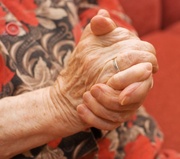 Photo: Getty Images
Photo: Getty Images
Known as a hand deformity that usually develops gradually over a number of years, Dupuytren’s contracture affects the connective tissue under the skin of the palm. With this disease, knots of tissue will begin to form under the skin, eventually creating a thick cord that can pull one or more of the fingers into a bent position.
Once this happens, the fingers cannot be straightened completely, and this can interfere with every day activities, such as putting one’s hands in pockets, shaking hands, or even putting on gloves. The simplest tasks in life become complicated.
Dupuytren’s contracture typically affects the ring finger and the pinkie finger, and is usually seen in older men of Northern European descent. Although this disease does develop slowly over decades, it can progress much more quickly in just weeks or months. For some patients, it is a steady progression, and for others, it comes and goes.
Dupuytren’s contracture is usually noticed first by the thickening of the skin on the palm of the hand. As the disease advances, the skin on the palm may seem dimpled or puckered. A firm lump of tissue may develop on the palm and may be sensitive to touch, although not necessarily painful.
In the advanced stages of the disease, the cords of tissue forming under the skin on the palm may move up to the fingers. When the cords begin to tighten up, the fingers are then pulled down towards the palm, quite severely in many cases.
Although doctors are uncertain as to the exact causes of Dupuytren’s contracture, some have speculated that it could be associated with an autoimmune reaction, wherein a person’s immune system begins to attack its own body tissues. Dupuytren’s is most notably seen in conjunction with other conditions that cause contractures in other areas of the body, such as in the feet (Ledderhose disease) or in the penis (Peyronie’s disease).
Among the risk factors for Dupuytren’s include age and sex. It is most commonly seen in people over the age of 50 and more often seen in men than in women. It is also hereditary. Smoking and alcohol use are contributing factors, as well, as smoking causes microscopic changes in the blood vessels. Those individuals with diabetes also have an increased risk of developing this condition.
Dupuytren’s contracture does make it a challenge to perform every day tasks, but since the thumb and index finger are not usually affected, finer activities such as writing are not usually inconvenienced. However, as the disease progresses, it can limit one’s ability to fully open the hand, and grasping large objects can be difficult.
If the disease does not progress quickly and the patient is not experiencing any pain or sees little impact on the ability to use the hands, treatment might not be necessary. Many patients at this point may opt to just see how the disease progresses and then decide as to what treatment measures to pursue.
Treatment for Dupuytren’s involves removing or breaking apart those cords that are pulling the fingers inward toward the palm of the hand. This can be done through the needling technique, wherein a needle is inserted through the skin in an effort to puncture and break the cord of tissue that is causing the contracture. Enzyme injections may soften and weaken the tight cord in the palm, as well. The day following the injection, the doctor will manipulate the hand in an effort to break the cord and straighten out the fingers. If surgery is necessary, the doctor will remove the tissue in the palm that has been affected by the disease. Post-surgery, physical therapy may be required and the recovery time can prove to be longer than when needling or enzyme injections are used.
If you are suffering from a mild case of Dupuytren’s contracture, you can stretch your fingers by gently bending them backward from your palm. Place your fingers on the edge of a table with your palm facing down and gradually lift your palm up, keeping the fingers flat on the table.
Massage and heat are effective as well. Warm up your hands with a warm heat pack before stretching and then massage your palms with lanolin cream. You can protect your hands by avoiding using a tight grip on tools and use gloves with heavy padding when performing tasks that require strong grasps.
Once you are on the road to recovery, be sure to confidently extend your hand to your doctor and firmly shake hands. While this simple task may have seemed daunting during the course of the disease, it will now seem like a walk in the park…which you can also do now with your dog, feeling comfortable that you can firmly hold onto the leash!
(Information for this article was found at http://orthoinfo.aaos.org/topic.cfm?topic=a00008)






Add a CommentComments
There are no comments yet. Be the first one and get the conversation started!